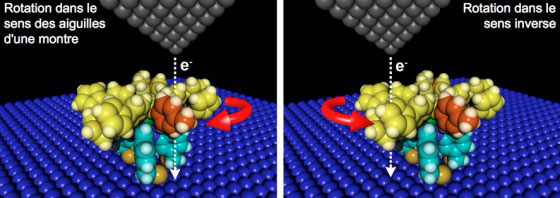| Jan 15, 2013 |
Controlling the direction of rotation of a 2 nm small molecular motor
|
|
(Nanowerk News) Researchers from Toulouse (CEMES) and Ohio University have developed a molecular motor 2 nm in diameter ("Controlled clockwise and anticlockwise rotational switching of a molecular motor"). This motor can be made to rotate in a clockwise or anticlockwise direction by selec tive inelastic electron tunnelling.
|
 |
| The molecule-motor is anchored on a surface via three bonds. The upper part rotate clockwise or anticlockwise depending of the position of the source of electrons, the microscope tip.
|
|
A rotative motor is a machine which transforms energy into a rotational motion able to achieve work. The molecular motor designed and synthesized at CEMES is anchored onto a surface.
|
|
The French and American research teams have observed and triggered a unidirectional rotational motion which can be controlled, clockwise or anticlockwise, depending on the stimulated zone of the molecule. The motor rotates by consuming the energy provided by the electron transfer originating from the tunneling current of a microscope. This directional control, combined with the possibility to revert the direction of rotation on demand, is a first.
|
|
The next step of this research is to evaluate the work produced by this rotation, in order to exploit this work at the nanoscale. Extremely miniaturized motors should lead to the design of nano electronic and mechanical devices, consuming less energy. On the longer term, the motors could embark on nanorobots or power nanovehicles that we develop separately.
|

